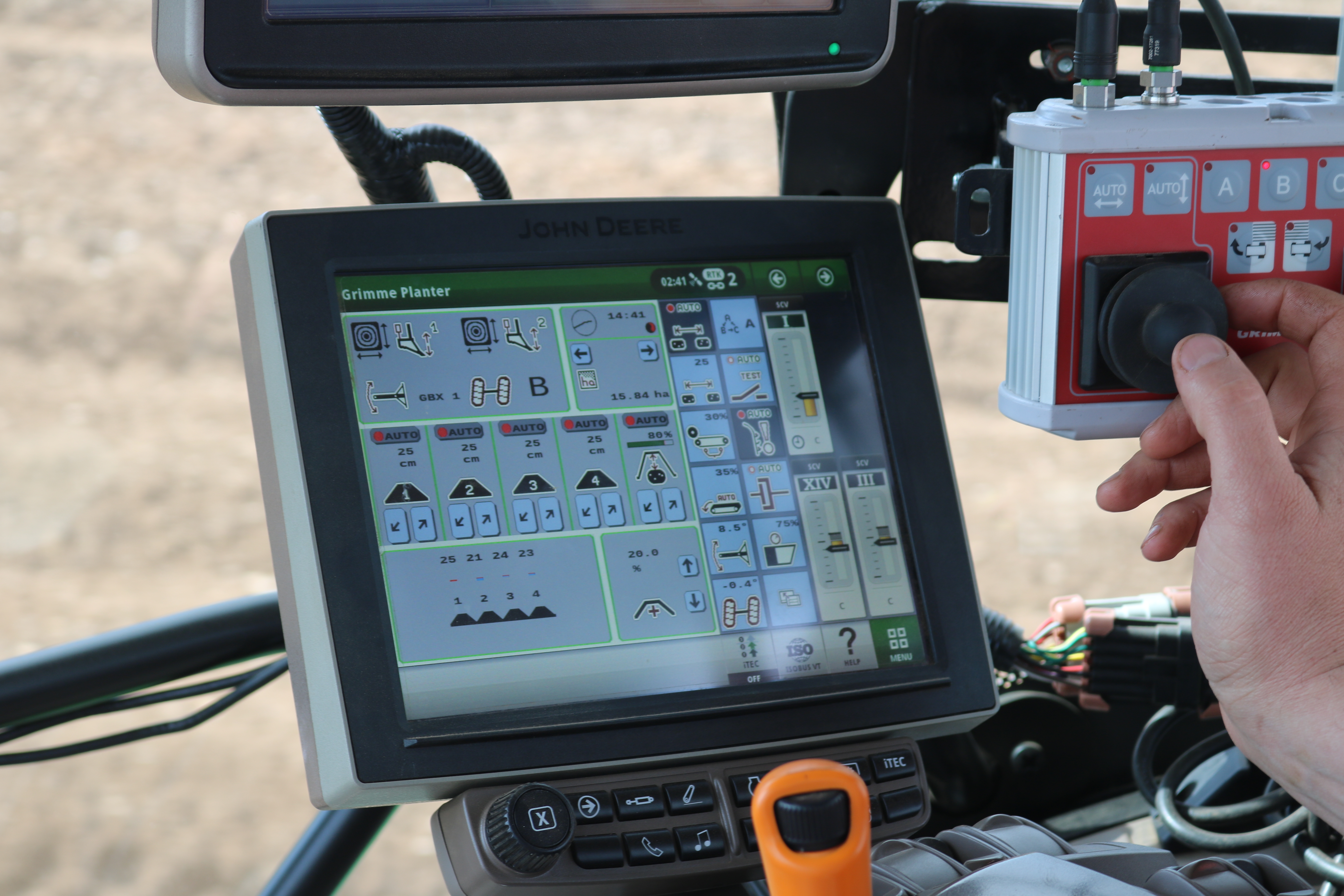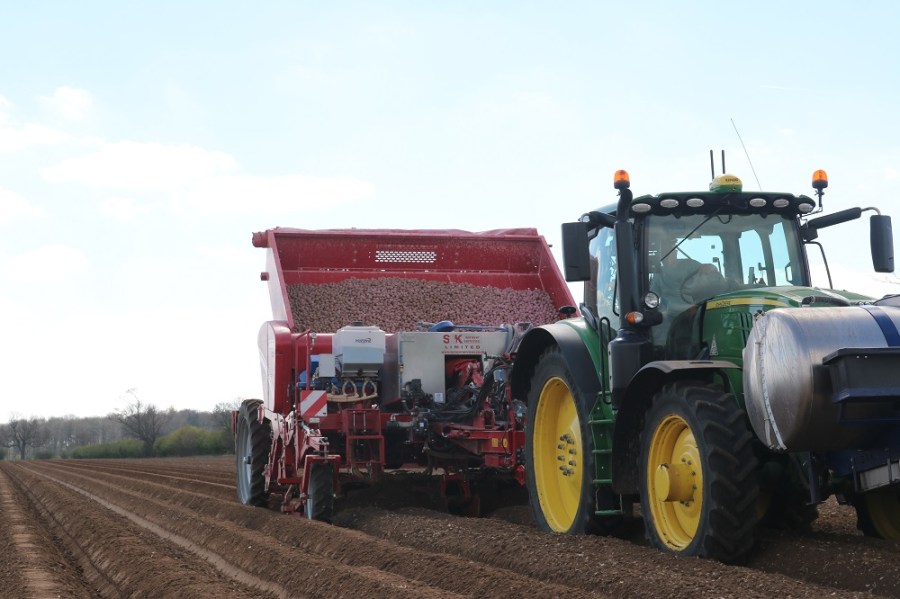There’s a lot going on with a potato planter, especially a modern four-row machine. CPM joins an operator in N Lincs to get a feel for the features that ensure a sound result.
With four rows to look after, it’s just as well most of the operations are automatic and it all self-adjusts.
By Tom Allen-Stevens
For a potato planter, the GB430 is undoubtedly a big machine, but surprisingly nimble as operator Martin Smith swings it round on the headland and lines it up for another run. A few skilful nudges of the joystick that operates the hydraulic steering, and the furrow openers are in place and back in work. A cacophony of beeps and buzzers then chime in to let him know the state of various operations taking place behind him.

With so many different controllers in the tractor cab, it’s just as well most of the operations on the planter are automatic.
“There’s always plenty going on and you get to know which buzzer means what after a while,” he notes. “With four rows to look after, it’s just as well most of the operations are automatic and it all self-adjusts.”
The focus is currently on the individual planting belts. Four of the planter’s six cameras beam the current state of play to the in-cab monitor. Martin’s in the shortwork of the field, and three lines of tubers wait in an orderly line, while just one belt passes the seed potatoes through in quick succession with the rate showing up on the terminal screen. After what seems like an excessively long pause, there’s yet another beep and the second line kicks in, followed eventually by the third and finally the fourth.
“Section control takes a lot of the thinking out of the job. It’s very easy to set up – you just set your headland width to 20m and everything is taken care of. You know the seed rate will be bang on.”
Nectar is currently the variety being put in the ground. “I’ve nipped the spacing up a bit as we’ve slightly more seed than we thought. But it’s dead easy to calibrate – you just set the rate you want through the terminal and check it over 100m. It then looks after itself.”
Having spent 24 years in the Royal Engineers, Martin left the Army and came to work for RJ and AE Godfrey, based in N Lincs. The business grows over 400ha of potatoes from the Lincs Wolds to the silt soils of Holbeach. Martin’s arrival on the farm coincided with the business’ first year with the Grimme GB430, and not afraid of a challenge, he put himself forward as its operator.
Currently working the soils of the Lincs Wolds, the GB430 has been following a pair of Grimme CS150 destoners that have prepared the beds for the four-row machine. A trailed model, it sits on the arms of a John Deere 6215R, offset on a linkage with a hydraulic actuator. The tractor straddles one bed with the planter spanning both that bed and another to its right. The conditions are just about ideal, and the ridges are leaving the long shaping hood perfectly formed.
“We did have a few problems last year,” reveals Martin. “We thought it would benefit the depth control on our slopes to put a bit of play into the Flow-Board and have two suspended two-row units. But we found it didn’t put enough of the planter’s weight on either pair of shaping hoods.”
It’s the sort of in-field trial work that Grimme UK’s only too happy to help with, notes marketing manager Adam Johnson, who’s on hand to provide some insight into the planter and the technology on board. “We’re always keen to work with growers to adapt machines to particular requirements. In this instance, it didn’t work out – it’s better to have the Flow-Board joined up so the full weight of the machine acts down on the hood, so it was returned back to the factory standard. But some of the best ideas on how Grimme machines have evolved have come from those who operate them.”
Planting the tubers is just one of the operations carried out in one pass, and various additions cling limpet-like to the main machine. Straddling the central drawbar is an S&K spray tank and unit that applies Amistar (azoxystrobin) to the furrow. A second S&K 1200-litre tank sits on the tractor’s front linkage, carrying liquid fertiliser into the rows. Finally, there’s a Horstine slug-pellet applicator sitting just to the right of the rear spray tank.
It means there’s not just a lot going on, but a fair weight of machine that’s being asked to perform a precision job, notes Martin. “With a full load of potatoes, there’s about 10t trailed behind, which can tend to pull you out on the side of one of our steep slopes. So it’s useful the have the autosteer to keep you on track.”
There’s also quite a lot that could go wrong with such a complex operation, he adds. “The thing about this machine is that if just one process goes, it shuts you down. Thankfully that’s a rare occurrence, and certainly this year it’s been phenomenal.”
He puts this down to a combination of factors. “It’s the quality of the machine – you get what you pay for, but we’ve also had very good after-sales service from Grimme. And we’ve kept it well serviced ourselves and made sure it was ready for the season – look after a machine and it’ll look after itself.”
Novel features aim for the perfect canopy
Uniform distribution
Perhaps the biggest advantage of a belt over a cup planter is the easy adjustment of planting rate. The rate itself is set through the in-cab terminal, with no need to hop out of the tractor and change sprocket wheels. The GB-Series belt planters take this a step further by monitoring the size of the tubers as they drop on to the belt, then the spacing is adjusted accordingly. This means the operator sets the number of tubers/ha, and the spacing is optimised, so it might vary within the row, but the correct number of tubers will be delivered across the field.
Clever Planting
This is a feature that reduces the chances of greening in the tramlines, resulting from sprayer passes through the crop. Clever Planting automatically adjusts seed spacing around sprayer tracks or where tramlining has taken place to ensure crop uniformity.
The ‘Kit Kat’ row
It’s probably what defines the GB-Series planters – that distinctive shape that maybe reminds you it’s time to take a break to admire your handiwork.
Behind it lies some pretty neat technology that earned Grimme a DLG silver medal in 2007. The Flow-Board delivers depth guidance without feeler wheels and is suspended with a sprung parallelogram frame underneath the machine. The furrow openers are integrated into this, with a mechanical link to the ridge shaper for setting the desired depth. A sensor captures the movement of the ridge shaper and subsequently controls the depth of the furrow openers via a hydraulic cylinder, maintaining the required soil coverage.
But it’s the long shaping hood that holds the soil together and delivers the distinctive smooth ridges. On uphill and downhill slopes, the planting elements are always kept horizontal, self-levelling by +/- 7°. The discharge point into the furrow opener as well as the dropping height of the potato isn’t changed by the slope compensation. Cage rollers are available for those who prefer a more fine, crumbled ridge structure.
High output
The step up in output is one of the most significant differences with the GB430. The average forward speed is around 8km/h – up to twice what you’d achieve with a cup planter. The belt delivery system ensures no doubles or misses, which can be a problem if you push output on a cup planter.
Everything on the GB430 is hydraulically driven, which makes a change from Grimme’s two-row equivalents. Where potatoes are planted into pre-prepared beds, the trailed model is able to plant two beds simultaneously using the offset method.
Technology cuts the clutter and boosts precision
Full ISOBUS capability
The GB-Series planters are the first to come to market fully ISOBUS-ready. This means you can plug your GB430 into a John Deere tractor, for example, and the GreenStar display terminal can be used to control the settings. This is now the case with all Grimme potato planters and beet drills.
There are two advantages here: firstly, it cuts down on the need for an extra GPS licence, which, depending on your service, can be a considerable saving.
It also reduces the amount of clutter and screens in the tractor cab – with potato planting often combined with an in-furrow spray, liquid fertiliser and a slug pellet application, one less screen to worry about in the cab can be worth more than might at first appear.
Optional on the GB-Series is Grimme’s nozzle and tank systems. While many prefer to bolt on systems from other manufacturers, these are factory-fitted and also come ISOBUS-ready, so can be controlled through the same terminal as the planter.
Section control
Not so much a worry for two-row planters, once you step up to a four-row version, section control adds a level of valuable precision. This is set up simply by loading field maps into the controller. Once you set the headland width, automatic single-row deactivation will shut off and start the hydraulic drive on each planting belt, cutting down on overlaps in shortwork.
Auto steering
The GB430 is a sizeable machine and can be a job to handle, especially the trailed model on the side of a steep slope. This is where autosteer comes in handy. A slave GPS unit on the planter feeds information through to the tractor on relative position and the rear wheels on the planter then automatically adjust to ensure the ‘Kit Kat’ rows stay true and straight. The wheels can be independently controlled with a joystick on the controller, allowing tight turns on headlands.
Terminal control and digital
Grimme is part of the CCI consortium and the GB-Series planters can be controlled with the CCI 100 terminal. Available on some Grimme machines is the new CCI 1200 terminal, which will come in the near future to the planters. This terminal adds a lot more functionality, not least of which is the ability to split the screen and monitor two functions at the same time.
The MyGrimme platform (available free on smartphone, tablet and PC) brings all of your Grimme machines and work documents into one place. Expect to see more functionality and services rolled out through this, or via the Agrirouter platform, of which Grimme is a founding partner.
MyGrimme serves as a quick reference point for specifications and you can use Google Maps to locate self-propelled machines (other machines will be included from 2020). Geofencing allows you to define a work area and will alert you if a nefarious individual has packed your planter onto a trailer and is setting off down the M1.
Machinery Masterclass
Technology is advancing fast, and the capabilities of equipment found on farm far outstrips what was available just five years ago. For growers who embrace the change, the potential to cut cost, refine production systems and boost output is immense. But how can you make an informed choice about whether an innovation will deliver the refinements you seek if you’ve not operated it before?
This is where Machinery Masterclass comes in. In this article, sponsored by Grimme, CPM has worked with the manufacturer to get a true user experience and an insight into the technology advances it has introduced. We hope this will bring you a ‘try before you buy’ feel for specific features found on this item of machinery and help you remain at the forefront of progression in crop production.




